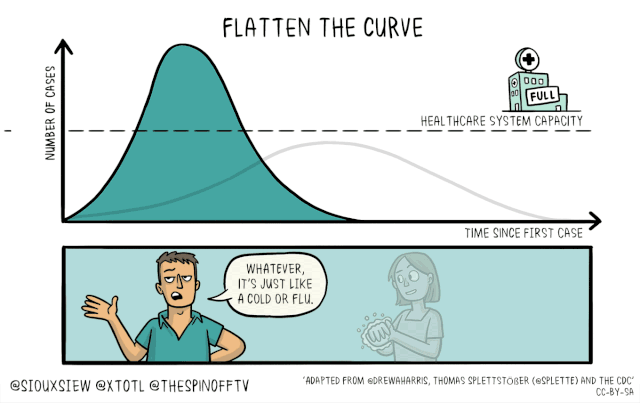Social Distancing
Original Editor - Wendy Walker.
Top Contributors - Wendy Walker, Nicole Hills, Admin, Kim Jackson, Wanda van Niekerk, Tarina van der Stockt, Vidya Acharya, Lucinda hampton and Nupur Smit Shah
Introduction[edit | edit source]
One of the most effective ways of limiting the spread of an infectious disease, for instance, Covid-19, is to practice Social Distancing. This is not a new concept, as most societies have been aware of the value of keeping away from people who are suffering from an infection for many generations.
What does Social Distancing Involve?[edit | edit source]
It is an action taken to minimise contact with other individuals.
It has been suggested that maintaining a distance of 1 to 2 metres from another individual results in a marked reduction in transmission of most flu virus strains, including COVID-19.
In practice, this means that avoiding close proximity to other people will aid in slowing the spread of infectious diseases. Social Distancing is one the non-pharmaceutical infection control actions which can be taken by public health organisations to stop or slow down the spread of a highly contagious disease[1].
How does it work?[edit | edit source]
The virus that causes COVID-19 is currently spreading easily from person-to-person.
When a healthy person comes into contact with the droplets from coughs and sneezes of an infected person, they are likely to catch the infection[2][3].
The World Health Organisation in their recent document about COVID-19 states "COVID-19 is transmitted via droplets and fomites during close unprotected contact between an infector and infectee". A fomite is an object or material which is likely to carry infection, such as clothes, utensils, and furniture. So staying away from other people, and thus reducing exposure to their coughs and sneezes, as well as from touching infected fomites, means that the transmission of infection is avoided.
Social distancing aims to decrease or interrupt transmission of COVID-19 in a population[4] by minimising contact between potentially infected individuals and healthy individuals; or between population groups with high rates of transmission and population groups with no or low levels of transmission.
How effective is it?[edit | edit source]
In epidemics of contagious diseases which are spread by droplet, Social Distancing has a useful effect. In epidemics of diseases which are spread by water contamination, it is not efficacious.
Studies of outbreaks of infectious diseases such as flu and their spread, suggest that Social Distancing is effective in reducing the number people infected, provided that the measures are thorough and that they are continued for a suitable length of time[5]. Studies on the 1918 influenza epidemic, comparing different states in the USA, demonstrated the benefits of applying Social Distancing[6][7].
Methods of Social Distancing[edit | edit source]
Prohibition of Mass Gatherings[edit | edit source]
Cancellation of events which involve large numbers of people gathering together, such as
- sports games
- work conferences
- theatre productions
- cinemas
Closure of community facilities[edit | edit source]
These facilities can include
- swimming pools
- gyms
- youth clubs
- community centres
Workplace Closure[edit | edit source]
- closure of non-essential workplaces
- of schools
- of colleges and universities
Self-shielding[edit | edit source]
- individuals limit face-to-face contacts
- individuals avoid public places
- individuals avoid public transport
Shut down/reduce Public Transport[edit | edit source]
Is Social Distancing a new concept?[edit | edit source]
No, it has been around for many generations and in many different regions of the world.
Resources[edit | edit source]
- bulleted list
- x
or
- numbered list
- x
References[edit | edit source]
- ↑ Ahmed F, Zviedrite N, Uzicanin A Effectiveness of workplace social distancing measures in reducing influenza transmission: a systematic review. BMC Public Health. 2018 Apr 18;18(1):518. doi: 10.1186/s12889-018-5446-1.
- ↑ "Q&A on coronaviruses". World Health Organization (WHO). 11 February 2020. Retrieved 13 March 2020
- ↑ Rothan HA, Byrareddy SN (February 2020). "The epidemiology and pathogenesis of coronavirus disease (COVID-19) outbreak". Journal of Autoimmunity: 102433.
- ↑ Wilder-Smith A, Freedman DO Isolation, quarantine, social distancing and community containment: pivotal role for old-style public health measures in the novel coronavirus (2019-nCoV) outbreak. J Travel Med. 2020 Feb 13. pii: taaa020. doi: 10.1093/jtm/taaa020. [Epub ahead of print]
- ↑ Maharaj S, Kleczkowski A (2012). "Controlling epidemic spread by social distancing: Do it well or not at all". BMC Public Health. 12 (1): 679.
- ↑ Hatchett RJ, Mecher CE, Lipsitch M (2007). "Public health interventions and epidemic intensity during the 1918 influenza pandemic". Proc Natl Acad Sci U S A. 104 (18): 7582–7587
- ↑ Bootsma MC, Ferguson NM (2007). "The effect of public health measures on the 1918 influenza pandemic in U.S. cities". Proc Natl Acad Sci U S A. 104 (18): 7588–7593







